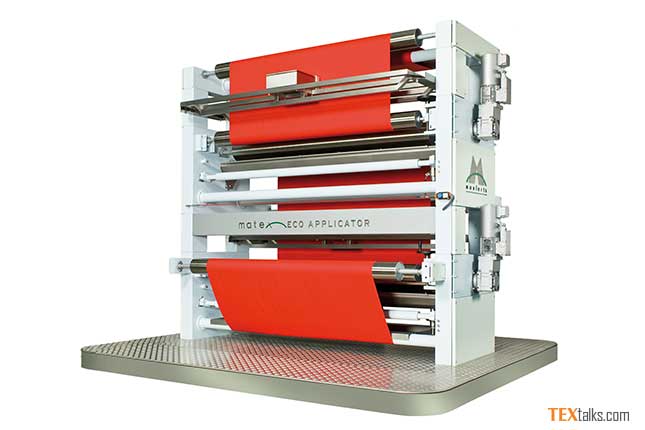A highly-controlled and contained environment was a key consideration when constructing the special line for technical textiles at the ATC.
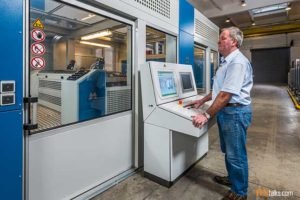
Mr Jürgen Hanel, Monforts Head of Technical Textiles explained, “Technical textiles are extremely diverse in their end-use applications and manufacturers can be called upon to quickly produce a succession of materials with widely differing properties and performance applications – often within a single shift. These range from substrates for digitally-printed soft signage to carbon fabrics for today’s high-performance composites, and from filter media which must perform in extreme temperatures to flame retardant barrier fabrics.”
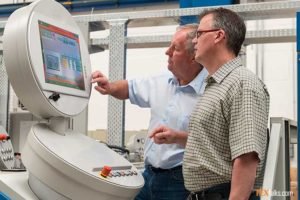
Then there are the heavy duty membranes which are employed in the collection and storage of methane in biogas plants, as well as materials equipped with sensors and electrical conductors which are now used as base liners in DSC solar cells, to name just a few examples.
These very different materials, however, have one thing in common – they all require expert coating and finishing for maximum efficiency and the technology to allow for ultimate flexibility and the ability to switch quickly from one fabric formula to the next, without compromising on the economical use of energy or raw materials.
Organic solvents
The technical textiles line at the ATC incorporates a Montex four-chamber, horizontal chain stenter and is fitted with an explosion-proof coating application chamber in order to allow treatment to be carried out with organic solvents and other volatile materials.
Mr Jürgen Hanel, Monforts Head of Technical Textiles said, “There has been wariness about handling organic solvents, but in the end, they’re not as difficult to coat on textile substrates as they are on plastic films where they’re already widely used and they offer a lot of possibilities for companies to explore and develop entirely new products – especially in fields such as medical and filtration.”
Every single component within the chamber has to meet the standards of the European Union’s ATEX directives for working in an explosive atmosphere. A range of sensors linked to alarms operate at various levels within the chamber to ensure the specified lower explosion limit (LOL) is never exceeded and the ventilation adapts accordingly.
Advanced functions
Special features on the finishing line relate to further advanced functions – the ability to treat materials not only at temperatures of up to 320°C, but also to be able to treat the top and bottom faces of certain materials at different temperatures within a single pass through the machine.
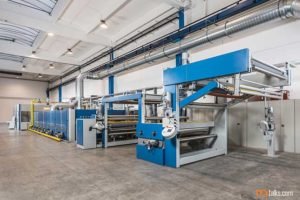
To achieve this, the first two chambers of the stenter are fitted with special, heavy duty TwinAir ventilation motors and separate burners for individual top/bottom temperature. A temperature differential of up to 60°C can be achieved between the upper and lower nozzles within the chamber.
There are many applications where employing two separate temperature treatments is beneficial, such as floorcoverings – where the textile face fabric is treated at one temperature and the rubber backing at another – as well as PVC flooring employing chemical foams or for materials like black-out roller blinds with heavy backings.
At the same time, in the pharmaceutical industry there is a wide range of different applications for organic solvents such as anti-septic treatments which have to be treated very carefully and applied at very specific temperatures in order not to destroy their efficacy.
Other materials, such as PTFE-coated filter materials are also applied and then cured at separate temperatures.
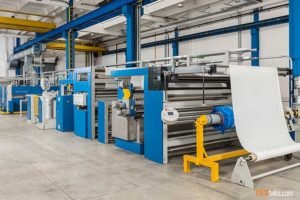
Stretching
Another key feature of the technical textiles line at the ATC is the special stretching device which is capable of pulling ten tons in length and ten tons in width – a huge amount per square metre of fabric and necessary in the production of materials such as woven or 3D knits for high temperature filter media.
Three weft straighteners – each with different key strengths – have been installed by Monforts ATC partners Erhardt and Leimer, Mahlo and Pleva.

Mr Heinrichs said, “This line has been engineered to provide the ultimate in precision coating finishing, in order to achieve the standards required by the medical companies, and also the quality standards in place for aerospace and automotive grade materials. We are always happy to discuss existing possibilities and the development of new concepts too.”
Knitwear
The second production line at the ATC has been engineered with the state-of-the art production of conventional knitwear in mind and is based around a Montex stenter with vertical chain return.
Mr Fred Vohsdahl, ATC manager explained, “Knitted fabrics must never be stretched and need to be treated in a relaxed state. As a consequence, the 2.2 metre wide, four-chamber stenter incorporates a TwinAir nozzle system to ensure the relaxed fabric is kept at a suitable height in between the upper and lower nozzle system, despite ‘bowing’. Exact selvedge control with the minimum pinning in is also extremely important with knitted fabrics.”
Eco Applicator
The line is also equipped with the company’s Eco Applicator system which eliminates the need for a conventional wet-on-wet padder, instead employing trough and roller techniques to precisely apply the required amount of liquid/coating to the fabric.
It is fitted with an advanced guidance system specially-adapted to the needs of delicate treatments and eliminating any possible ‘curling’ of the fabric edges prior to entering the stenter.
For conventional woven and knitted fabrics, the Monforts Eco Applicator has been highly successful since its introduction in 2011, both integrated into new finishing lines and retro-fitted to existing ones.
Mr Fred Vohsdahl, ATC manager said, “In many textile mills globally, the cost of running integrated manufacturing lines – especially those for fabric finishing that can involve numerous sequences of heating and subsequent drying – is now eclipsing the cost of paying people to operate them. The ability of the Eco Applicator to significantly reduce energy costs is the key reason for its rapid acceptance on the market. The unit itself does not actually save the energy, but by applying only the precise amount of functional finish, ensures the subsequent drying time is shorter – in some cases dramatically so.”
Compared with a padder system, where the initial moisture content of the fabric entering the stenter is 60%, with the Eco Applicator it is reduced to 40% and the system also has the shortest fabric path from the coating unit into the stenter.
The Eco Applicator’s versatility also allows mills to apply finishes to just one side of the fabric, or both, and even to apply separate finishes to each side, or to specific areas of a fabric, for endless possibilities, whether treating wovens, denim or delicate knits.
The next level
Mr Klaus Heinrichs concluded, “The ATC draws on all of the know-how of our company in respect of fabric processing. Whatever your company’s specialism, we have the technologies and the process knowledge to help you take your business to the next level.”


